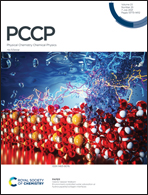Origin of the hydrophobicity of sulfur-containing iron surfaces†
Abstract
Sulfur-containing iron materials such as sulfidized nanoscale zerovalent iron (SNZVI) have shown outstanding water remediation performance in many recent studies, which is largely attributed to its high hydrophobicity compared to that of NZVI. However, the role of sulfur in the reactions, and the origin of the hydrophobicity of SNZVI, were still unclear. In this paper, for the first time, we conducted ab initio molecular dynamics simulation using an explicitly solvated model on both Fe and S-containing Fe surfaces, to explore the hydrophobicity of S-containing Fe materials. We found that the high hydrophobicity of these S-containing Fe surfaces originates from the hydrophobic nature of S: both doping S on top of the Fe surface and inserting S onto an Fe surface can significantly improve the surface hydrophobicity by increasing the distance between the water layer and the Fe surface. This exposes empty Fe sites which do not interact with water and in turn reduces hydrogen evolution. To compare with the theoretical analysis, we experimentally analyzed the hydrophobicity of both NZVI and SNZVI surfaces, leading to a good agreement with our theoretical analysis. We then theoretically show that the doping of other p-block elements (e.g., N and P) to iron surfaces can also create a hydrophobic phenomenon. Most importantly, this study points out that the potential contribution of hydrophobicity to the reactivity on liquid-phase reaction materials should not be ignored in the mechanistic analysis.



 Please wait while we load your content...
Please wait while we load your content...